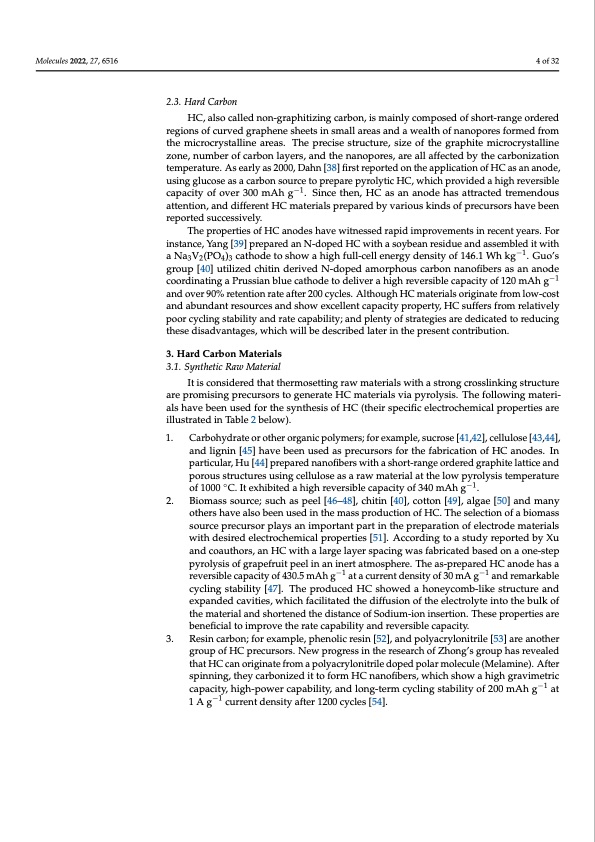
PDF Publication Title:
Text from PDF Page: 004
Molecules 2022, 27, 6516 4 of 32 2.3. Hard Carbon HC, also called non-graphitizing carbon, is mainly composed of short-range ordered regions of curved graphene sheets in small areas and a wealth of nanopores formed from the microcrystalline areas. The precise structure, size of the graphite microcrystalline zone, number of carbon layers, and the nanopores, are all affected by the carbonization temperature. As early as 2000, Dahn [38] first reported on the application of HC as an anode, using glucose as a carbon source to prepare pyrolytic HC, which provided a high reversible capacity of over 300 mAh g−1. Since then, HC as an anode has attracted tremendous attention, and different HC materials prepared by various kinds of precursors have been reported successively. The properties of HC anodes have witnessed rapid improvements in recent years. For instance, Yang [39] prepared an N-doped HC with a soybean residue and assembled it with a Na3V2(PO4)3 cathode to show a high full-cell energy density of 146.1 Wh kg−1. Guo’s group [40] utilized chitin derived N-doped amorphous carbon nanofibers as an anode coordinating a Prussian blue cathode to deliver a high reversible capacity of 120 mAh g−1 and over 90% retention rate after 200 cycles. Although HC materials originate from low-cost and abundant resources and show excellent capacity property, HC suffers from relatively poor cycling stability and rate capability; and plenty of strategies are dedicated to reducing these disadvantages, which will be described later in the present contribution. 3. Hard Carbon Materials 3.1. Synthetic Raw Material It is considered that thermosetting raw materials with a strong crosslinking structure are promising precursors to generate HC materials via pyrolysis. The following materi- als have been used for the synthesis of HC (their specific electrochemical properties are illustrated in Table 2 below). 1. Carbohydrate or other organic polymers; for example, sucrose [41,42], cellulose [43,44], and lignin [45] have been used as precursors for the fabrication of HC anodes. In particular, Hu [44] prepared nanofibers with a short-range ordered graphite lattice and porous structures using cellulose as a raw material at the low pyrolysis temperature of 1000 ◦C. It exhibited a high reversible capacity of 340 mAh g−1. 2. Biomass source; such as peel [46–48], chitin [40], cotton [49], algae [50] and many others have also been used in the mass production of HC. The selection of a biomass source precursor plays an important part in the preparation of electrode materials with desired electrochemical properties [51]. According to a study reported by Xu and coauthors, an HC with a large layer spacing was fabricated based on a one-step pyrolysis of grapefruit peel in an inert atmosphere. The as-prepared HC anode has a reversible capacity of 430.5 mAh g−1 at a current density of 30 mA g−1 and remarkable cycling stability [47]. The produced HC showed a honeycomb-like structure and expanded cavities, which facilitated the diffusion of the electrolyte into the bulk of the material and shortened the distance of Sodium-ion insertion. These properties are beneficial to improve the rate capability and reversible capacity. 3. Resin carbon; for example, phenolic resin [52], and polyacrylonitrile [53] are another group of HC precursors. New progress in the research of Zhong’s group has revealed that HC can originate from a polyacrylonitrile doped polar molecule (Melamine). After spinning, they carbonized it to form HC nanofibers, which show a high gravimetric capacity, high-power capability, and long-term cycling stability of 200 mAh g−1 at 1 A g−1 current density after 1200 cycles [54].PDF Image | Hard Carbons as Anodes in Sodium-Ion Batteries

PDF Search Title:
Hard Carbons as Anodes in Sodium-Ion BatteriesOriginal File Name Searched:
molecules-27-06516-v2.pdfDIY PDF Search: Google It | Yahoo | Bing
Salgenx Redox Flow Battery Technology: Salt water flow battery technology with low cost and great energy density that can be used for power storage and thermal storage. Let us de-risk your production using our license. Our aqueous flow battery is less cost than Tesla Megapack and available faster. Redox flow battery. No membrane needed like with Vanadium, or Bromine. Salgenx flow battery
| CONTACT TEL: 608-238-6001 Email: greg@salgenx.com | RSS | AMP |